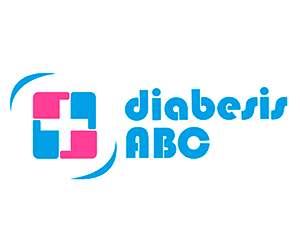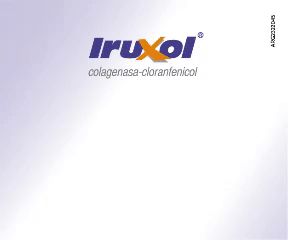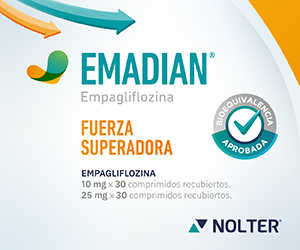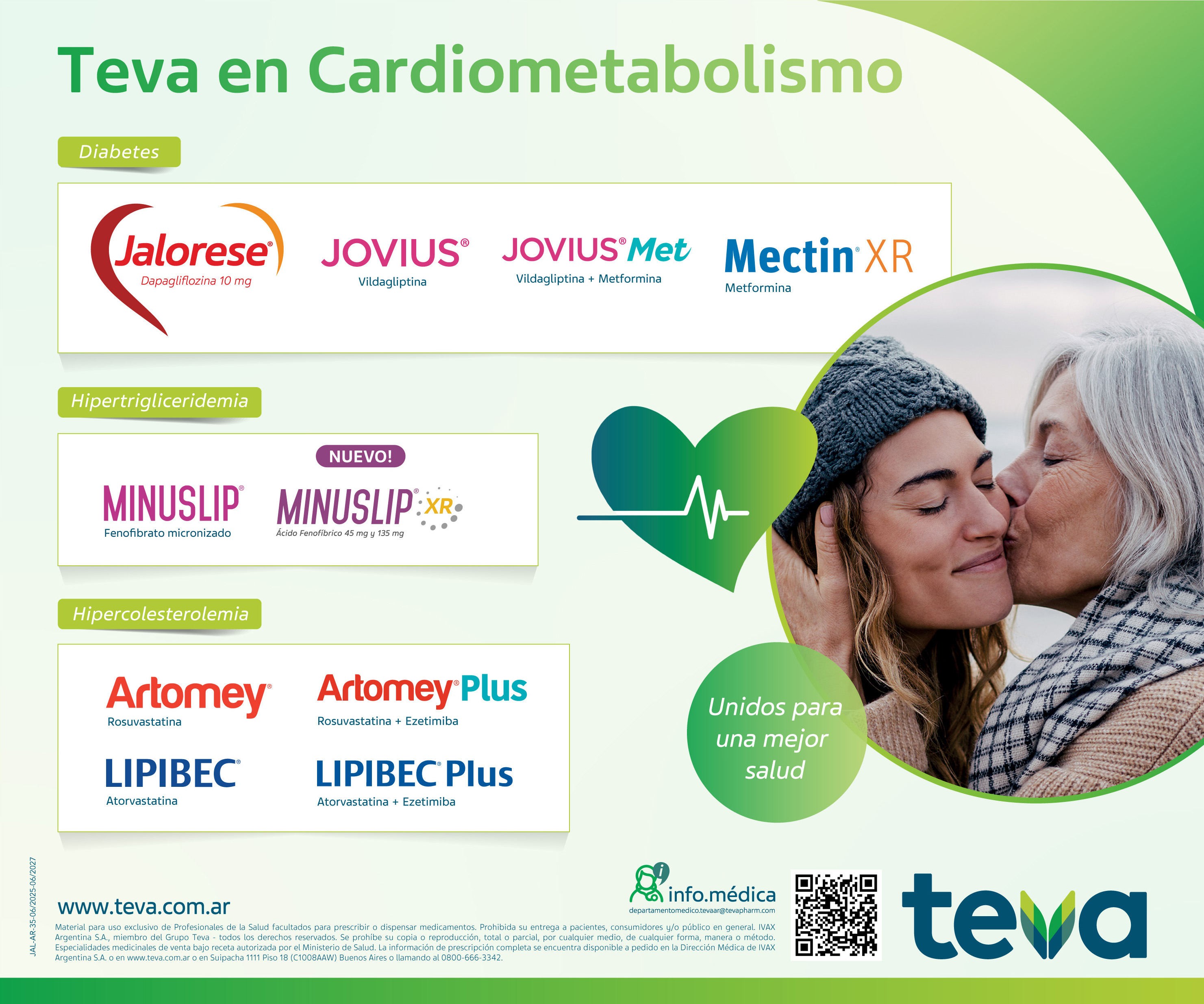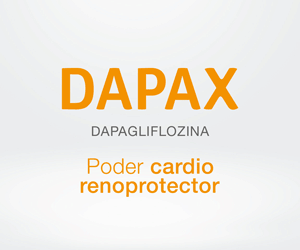Guías para el tratamiento de la diabetes mellitus tipo 2. Sociedad Argentina de Diabetes
DOI:
https://doi.org/10.47196/diab.v50i2.2Palabras clave:
diabetes mellitus tipo 2, guías, tratamientoResumen
Objetivos: 1) actualizar la Guía de Tratamiento de la Diabetes Mellitus tipo 2 de la Sociedad Argentina de Diabetes publicada en el año 2010; 2) proveer al equipo de salud una herramienta actualizada para el manejo terapéutico de las personas con esta patología.
Materiales y métodos: se convocó a un grupo de expertos, miembros titulares de la Sociedad Argentina de Diabetes, para analizar los trabajos disponibles en distintas fuentes, clasificándolos de acuerdo a su nivel de evidencia (Tabla 2), éste podrá observarse en negrita al final del párrafo correspondiente; sobre esta base se modificó la guía 2010 actualizando sus contenidos.
Se designó un comité de redacción responsable de la compaginación final del documento.
Conclusiones: los cambios en el estilo de vida continúan siendo la primera opción terapéutica, la metformina es la droga de primera línea, si no existen contraindicaciones para su uso o intolerancia, cualquiera de las otras familias de fármacos antidiabéticos, la insulina y sus análogos pueden usarse como monoterapia o asociadas entre sí teniendo en cuenta sus contraindicaciones, siempre y cuando no se utilicen juntas aquellas con mecanismos de acción similar. Los algoritmos 1 y 2 pueden considerarse la síntesis de la propuesta actual, elaborada para orientar la toma de decisiones respecto del tratamiento de la DMT2.
Citas
Aschner P, Aguilar Salinas C, Aguirre L, et al. Diabetes in South and Central America: An update. Diabetes Res Clin Pract 2014; 103 (2): 238-243.
Han Cho N, Colagiuri S, Distiller L, Dong B, Dunning T, Gadsby R, Goel A, Munshi M, Sinclair A, Sinay I. IDF Global guideline for managing older people with type 2 diabetes. International Diabetes Federation: Brussels, Belgium; 2013.
IDF Diabetes Atlas, 6th Ed., International Diabetes Federation: Brussels, Belgium; 2013.
Guariguata L, Whiting DR, Hambleton J, et al. Global estimates of diabetes prevalence for 2013 and projections for 2035. Diabetes Research and Clinical Practice 2014; 2:137-149.
Gagliardino JJ, Olivera EM. Aspecto socioeconómico de la diabetes mellitus en Argentina: diagnóstico epidemiológico. Epidemiología y atención de la salud en la Argentina. Buenos Aires: OPS, AMA. 1993 (Publicación 35).
Sereday M, González C, Giorgini D, De Loredo L, Braguinsky J, Cobeñas C, Libman C, Tesone C. Prevalence of diabetes, obesity, hypertension and hyperlipidemia in the central area of Argentina. Diabetes Metab 2004; 30:335-339.
Primera Encuesta Nacional de Factores de Riesgo. Primera Edición. Buenos Aires, Ministerio de Salud de la Nación, 2006. Disponible en: http://estadistica.cba.gov.ar/LinkClick.aspx?fileticket=dSgrqG0E0iY%3D&tabid=390&language=es-AR.
Segunda Encuesta Nacional de Factores de Riesgo. Primera Edición. Buenos Aires, Ministerio de Salud de la Nación, 2011. Disponible en: http://www.msal.gob.ar/images/stories/bes/graficos/0000000570cnt-2014-10_encuesta-nacional-factores-riesgo-2011_informe-final.pdf
Tercera Encuesta Nacional de Factores de Riesgo para Enfermedades No Transmisibles. Primera Edición. Buenos Aires, Ministerio de Salud de la Nación, Instituto Nacional de Estadísticas y Censos, 2015. Disponible en: http://www.msal.gob.ar/images/stories/bes/graficos/0000000544cnt-2015_09_04_encuesta_nacional_factores_riesgo.pdf
PRODIABA: Programa de Prevención, Atención y Tratamiento del Paciente Diabético. Día D: Frecuencias, causas y duración de la internación de los pacientes diabéticos en hospitales públicos de la Provincia de Buenos Aires. Revista de la ALAD 1995; 3:79.
Gagliardino J. Evaluación preliminar de la calidad de atención de personas con diabetes en Argentina. Revista de la Sociedad Argentina de Diabetes 2001; 35:121-133.
The Look AHEAD Research Group. Cardiovascular effects of intensive lifestyle intervention in type 2 diabetes. N Engl J Med 2013; 369:145-154.
Standards of Medical Care in Diabetes 2015. Diabetes Care 2015; 38:S1-S93.
Castagneto M, De Gaetano A, Mingrone G. Normalization of insulin sensitivity in the obese patient after stable weight reduction with biliopancreatic diversion. Obes Surg, 1994, 4: 161-168.
Markovic TP, Campbell LV, Balasubramanian S, Jenkins AB, Fleury AC, Simons LA, Chisholm DJ. Beneficial effect on average lipid levels from energy restriction and fat loss in obese individuals with or without type 2 diabetes. Diabetes Care 1998, 21: 695-700.
Christiansen MP, Linfoot PA, Neese RA, Hellerstein MK. Effect of dietary energy restriction on glucose production and substrate utilization in type 2 diabetes. Diabetes 2000, 49: 1691-1699.
Guía de práctica clínica sobre prevención, diagnóstico y tratamiento de la diabetes mellitus tipo 2 en el primer nivel de atención. Ministerio de Salud de la Nación, 2009, 1-122.http://www.solesdebuenosaires.org.ar/Guias/MS-695-09%20Guia%20Diabetes.pdf
Brown SA, Upchurch S, Anding R, Winter M, Ramìrez G. Promoting weight loss in type II diabetes. Diabetes Care, 1996. 19(6): 613-24. 6 (Suppl 2): 51S-209 S.
Moore H, Summerbell C, Hooper L, Cruickshank K, Vyas A, Johnstone P, Ashton V, Kopelman P. Dietary advice for treatment of type 2 diabetes mellitus in adults; 2004, Pub 3, CD004097,10:1002/1465-1858.
Brynes AE, Mark Edwards C, Ghatei MA, Dornhorst A; Morgan LM; Bloom SR; Frost GS. A randomised four-intervention crossover study investigating the effect of carbohydrates on daytime profiles of insulin, glucose, non-esterified fatty acids and triacylglycerols in middle-aged men. Br J Nutr 2003, 89: 207-218.
Abbott WG, Boyce VL, Grundy SM, Howard BV. Effects of replacing saturated fat with complex carbohydrate in diets of subjects with NIDDM Diabetes Care, 1989. 12: 102-107.
Mensink RP, Zock PL, Kester AD, Katan MB. Effects of dietary fatty acids and carbohydrates on the ratio of serum total to HDL cholesterol and on serum lipids and apolipoproteins: a metaanalysis of 60 controlled trials. Am J Clin Nutr, 2003, 77: 1146-1155.
Christiansen E, Schnider S, Palmvig B, Tauber-Lassen E, Pedersen O. Intake of a diet high in trans monounsaturated fatty acids or saturated fatty acids: effects on postprandial insulinemia and glycemia in obese patients with NIDDM. Diabetes Care 1997; 20: 881-887.
Riccardi G, Rivellese A, Pacioni D, Genovese S, Mastranzo P. Separate influence of dietary carbohydrate and fibre on the metabolic control in diabetes. Diabetologia 1984, 26: 116-121.
Lousley SE, Jones DB, Slaughter P, Carter RD, Jelfs R, Mann JI. High carbohydrate-high fibre diets in poorly controlled diabetes. Diabet Med 1984, 1: 21-25.
Yeh GY, Eisenberg DM, Kaptchuk TJ, Phillips RS. Systematic review of herbs and dietary supplements for glycemic control in diabetes. Diabetes Care 2003, 26: 1277-1294.
Althuis MD, Jordan NE, Ludington EA, Wittes JT. Glucose and insulin responses to dietary chromium supplements: a meta-analysis. Am J Clin Nutr 2002, 76: 148-155.
Ekinci EI, Clarke S, Thomas MC, Moran JL, Cheong K, Macisaac RJ, Jerums G. Dietary salt intake and mortality in patients with type 2 diabetes. Diabetes Care 2011, 34: 703-709.
Garg A. High-monounsaturated-fat diets for patients with diabetes mellitus: a meta-analysis. Am J Clin Nutr 1998; 67 (Suppl 1): 577-582.
Alam S, Johnson AG. A meta-analysis of randomised controlled trials (RCT) among healthy normotensive and essential hypertensive elderly patients to determine the effect of high salt (NaCl) diet on blood pressure. J Hum Hypertens 1999; 13: 367-374.
Hooper L, Bartlett C, Davey Smith G, Ebrahim S. Systematic review of long term effects of advice to reduce dietary salt in adults. BMJ 2002; 325 (7365): 628-637.
Samaha FF, Iqbal N, Seshadri P, Kathryn L, Chicano KL, Daily DA, McGrory J, Williams T, William M, Gracely EJ, Stern L. A low carbohydrate as compared with a low-fat diet in severe obesity. N Engl J Med 2003, 348: 2074-2081.
Tsihlias EB, Gibbs AL, McBurney MI, Wolever TM. Comparison of high and lowglycemicindex breakfast cereals with monounsaturated fat in the long-term dietary management of type 2 diabetes. Am J Clin Nutr, 2000. 72: 439-449.
Farmer A, Montori V, Dinneen S, Clar C. Fish oil in people with type 2 diabetes mellitus. Cochrane Database Syst Rev, 2001: CD003205.
Canadian Diabetes Association. Clinical Practice Guidelines 2008, 1-201. Disponible en: http://www.diabetes.ca/for-professionals/resources/2008-cpg.
Gill JM, Cooper AR. Physical activity and prevention of type 2 diabetes mellitus. Sports Med. 2008; 38: 807-814.
Cox KL, Burke V, Morton AR, Beilin LJ, Puddey IB. Independent and additive effects of energy restriction and exercise on glucose and insulin concentrations in sedentary overweight men. Am J Clin Nutr 004; 80308-80316.
Miller WC, Koceja DM, Hamilton EJ. A meta-analysis of the past 25 years of weight loss research using diet, exercise or diet plus exercise intervention. Int J Obes Relat Metab Disord. 1997; 21: 941-947.
Lee IM, Djoussé L, Sesso HD, Wang L, Buring JE. Physical activity and weight gain prevention. JAMA. 2010; 303: 1173-1179.
Pan XR, Li GW, Hu YH, Wang JX, Yang WY, An ZX, Hu ZX, Lin J, Xiao JZ, Cao HB, Liu PA, Jiang XG, Jiang YY, Wang JP, Zheng H, Zhang H, Bennett PH, Howard BV. Effects of diet and exercise in preventing NIDDM in people with impaired glucose tolerance. The Da Qing IGT and Diabetes Study. Diabetes Care 1997; 20: 537-544.
Uusitupa M, Louheranta A, Lindström J, Valle T, Sundvall J, Eriksson J, Tuomilehto J. The Finnish Diabetes Prevention Study. Br J Nutr 2000; 83 Suppl 1: S 137-42.
Lindström J, Peltonen M, Eriksson JG, Aunola S, Hämäläinen H, Ilanne-Parikka P, Keinänen-Kiukaanniemi S, Uusitupa M, Tuomilehto J. Finnish Diabetes Prevention Study (DPS) Group. Determinants for the effectiveness of lifestyle intervention in the Finnish Diabetes Prevention Study. Diabetes Care 2008; 31: 857-862.
No authors listed, Diabetes Prevention Program Group. Diabetes Care 1999; 23:623-634.
Boulé NG, Kenny GP, Haddad E, Wells GA, Sigal RJ. Meta-analysis of the effect of structured exercise training on cardiorespiratory fitness in type 2 diabetes mellitus. Diabetologia. 2003; 46: 1071-1081.
Thomas DE, Elliott EJ, Naughton GA. Exercise for type 2 diabetes mellitus. Cochrane Database Syst Rev. 2006; 3: CD002968.
Kelley GA, Kelley KS. Effects of aerobic exercise on lipids and lipoproteins in adults with type 2 diabetes: a meta-analysis of randomized-controlled trials. Public Health. 2007; 121: 643-655.
Kelley DE, Goodpaster BH. Effects of exercise on glucose homeostasis in type 2 diabetes mellitus. Med Sci Sports Exerc. 2001; 33 (6 Suppl): S 495-501.
Whelton SP, Chin A, Xin X, He J. Effect of aerobic exercise on blood pressure: a metaanalysis of randomized, controlled trials. Ann Intern Med. 2002; 136: 493-503.
Ekelund U, Ward HA, Norat T, Luan J, May E, Weiderpass E, Sharp SS, et al. Physical activity and all-cause mortality across levels of overall and abdominal adiposity in European men and women: the European Prospective Investigation into Cancer and Nutrition Study (EPIC). Am J Clin Nutr 2015 doi: 10.3945/ajcn.114.100065.
Hundal RS, Krssak M, Dufour S, Laurent D, Lebon V, Chandramouli V, Inzucchi SE, Schumann WC, Petersen KF, Landau BR, Shulman GI. Mechanism by which metformin reduces glucose production in type 2 diabetes. Diabetes 2000, 49: 2063-2069.
Foretz M, Guigas B, Bertrand L, Pollak M, Viollet B. Metformin: from mechanisms of action to therapies. Cell Metab. 2014; 20 (6): 953-66.
Bailey C, Turner R. Metformin, review article. New Engl J Med 1996, 334: 574-579.
Bloomgarden Z. Approaches to treatment of type 2 diabetes. Diabetes Care, 2008; 31: 1697-1703.
Cusi K, De Fronzo R. Metformin: a review of its metabolic effects. Diabetes Rev 1998, 6: 89131.
De Fronzo R, et al. Multicenter Metformin Study Group. N Engl J Med 1995, 333: 541-549.
Kothny W, Foley J, Kozlovski P, Shao Q, Gallwitz B, Lukashevich V. Improved glycaemic control with vildagliptin added to insulin, with or without metformin, in patients with type 2 diabetes mellitus. Diabetes, obesity and metabolism 2013, 15: 252-257.
Brackett C. Clarifying metformin's role and risks in liver dysfunction. Pharm D J Am Pharm Assoc 2010; 50: 407-410.
Herman W, Hoerger T, Brandle M, Hicks K, Sorensen S, Zhang P. The cost-effectiveness of lifestyle modification or metformin in preventing type 2 diabetes in adults with impaired glucose tolerance. Ann Intern Med 2005, 142: 323-332.
Hundal R, Inzucchi SE. Metformin: new concepts, new uses. Drugs 2003,63: 1879-1894.
Iki-Jarvinen H. Metformin prevents weight gain by reducing dietary intake during insulin therapy in patients with type 2 diabetes mellitus. Drugs 1999, Suppl 1: 53-54.
Johanssen K. Efficacy of metformin in the treatment of NIDDM, meta-analysis. Diabetes Care 1999, 22: 33-37.
Chiquette E, Ramirez G, DeFronzo R. A meta-analysis comparing the effect of thiazolidinediones on cardiovascular risk factors. Arch Intern Med. 2004; 164: 2097-2104.
Lebovitz HE, Dole JF, Patwardhan R, Rappaport EB, Freed MI. Rosiglitazone monotherapy is effective in patients with type 2 diabetes. J Clin Endocrinol Metab 2001; 86: 280-288.
Kahn SE, Haffner SM, Heise MA, Herman WH, Holman RR, Jones NP, Kravitz BG, Lachin JM, O'Neill MC, Zinman B, Viberti G; ADOPT Study Group. Glycemic durability of rosiglitazone, metformin, or glyburide monotherapy. N Engl J Med 2006, 355: 2427-2443.
Dormandy JA, Charbonnel B, Eckland EJA, Erdmann E, Massi-Benedetti M, Moules IK, et al. Secondary prevention of macrovascular events in patients with type 2 diabetes: a randomized trial of pioglitazone: the PROactive Study (PROspective pioglitAzone Clinical Trial In macro Vascular Events). Lancet 2005, 366: 1279-1289.
Nissen S, Wolski N. Effect of rosiglitazone on the risk of myocardial infarction and death from cardiovascular causes. N Engl J Med 2007; 356: 2457-2471.
Home P, Pocock SJ, Beck-Nielsen H, Curtis PS, Gomis R, Hanefeld M, Jones NP, et al. RECORD Study Team. Rosiglitazone evaluated for cardiovascular outcomes in oral agent combination therapy for type 2 diabetes. A multicentre, randomised, open-label trial.Lancet. 2009 20; 373: 2125-2135.
Gerstein HC, Yusuf S, Bosch J, Pogue J, Sheridan P, Dinccag N, et al: Effect of rosiglitazone on the frequency of diabetes in patients with impaired glucose tolerance or impaired fasting glucose: a randomised controlled trial. Lancet. 2006; 368: 1096-1105.
AACE Diabetes Mellitus Clinical Practice Guidelines Task Force. American Association of Clinical Endocrinologists medical guidelines for clinical practice for the management of diabetes mellitus. Endocr Pract. 2007; 13 (Suppl 1): 3-68.
Completion of the Post-Marketing Commitment to Submit Data to the FDA. First Word Pharma, 28, August 2014. http://www.firstwordpharma.com/node/1232261#axzz3BlGF2Jfp.
Schernthaner G, Currie CJ, Schernthaner GH. Do we still need pioglitazone for the treatment of type 2 diabetes? Diabetes Care 2013; 36: 155-161.
Nathan DM, Buse JB, Davidson MB, et al. Medical management of hyperglycemia in type 2 diabetes: a consensus algorithm for the initiation and adjustment of therapy. A consensus statement of the American Diabetes Association and the European Association for the Study of Diabetes. Diabetes Care. 2009; 32: 193-203.
Cook CJ, Girman CJ, Stein PP, Alexander CM, Holman RR. Glycemic control continues to deteriorate after sulfonylureas are added to metformin in patients with type 2 diabetes. Diabetes Care 2005: 28: 995-1000.
Saad MF, Kahn SE, Nelson RG, Pettitt DJ, Knowler WC, Schwartz MW, et al. Disproportionately elevated proinsulin in Pima Indians with noninsulin-dependent diabetes mellitus. J Clin Endocrinol Metab. 1990, 70: 1247-1253.
The UKPDS study group. Intensive blood glucose control with sulphonyureas or insulin compared with conventional treatment and risk of complications in patients with type 2 diabetes (UKPDS 33) Lancet 1998; 353: 837-853.
Schopman JE, Simon AC, Hoefnagel SJ, Hoekstra JB, Scholten RJ, Holleman F. The incidence of mild and severe hypoglycaemia in patients with type 2 diabetes mellitus treated with sulfonylureas: a systematic review and meta-analysis. Diabetes Metab Res Rev. 2014; 30 (1): 11-22.
Simpson SH, Majumdar SR, Tsuyuki RT, Eurich DT, Johnson JA. Dose response relation between sulfonylureas drugs and mortality in type 2 diabetes. CMAJ 2006: 169-174.
Rosenstock J, Hassman DR, Madder RD, Brazinsky S, Farrell J, Khutoryansky N, Hale P. Repaglinide versus nateglinide monotherapy: a randomized, multicenter study. Diabetes Care 2004, 27: 1265-1270.
Gerich J, Raskin P, Jean-Louis L, Purkayastha D, Baron MA. PRESERVE-beta: two year efficacy and safety of initial combination therapy with nateglinide or glyburide plus metformin. Diabetes Care 2005, 28: 2093-2099.
Nathan D. Finding new treatments for diabetes: How many, how fast, how good. N Engl J Med: 2007, 356: 5: 437-440.
Ruiz M, Matrone A, Alvariñas J, Burlando G, Tesone P, Jorge A. Estudio multicéntrico para determinar eficacia y tolerancia de acarbosa en pacientes con diabetes no insulinodependiente. Prensa Med Arg. 1996: 83: 392-398.
Chiasson JL, Gomis R, Hanefeld M, Josse RG, Karasik A, Laakso M, and The STOP-NIDDM Trial Research Group. The STOP-NIDDM Trial: An international study on the efficacy of an α-glucosidase inhibitor to prevent type 2 diabetes in a population with impaired glucose tolerance: rationale, design, and preliminary screening data. Diabetes Care, 1998, 21: 1720-1725.
Klonoff D, Busse J, Nielsen L, Guan Xuenson, Bowlus Ch, Holcombe J, Wintle M, Maggs D. Exenatide effects on diabetes, obesity, cardiovascular risk factors and hepatic biomarkers in patients with type 2 diabetes treated for at least 3 years. Curr Med Res Opinion 2008, 24: 275-286.
Van del Koppel S, Choe E, Sweet B. Managed care perspective on three new agents for type 2 diabetes. J Manag Care Pharm 2008,14: 363-380.
Farilla L, Bulotta A, Hirshberg B, Li Calzi S, Khoury N, Noushmehr H, Bertolotto C, Di Mario U, Harlan DM, Perfetti R. Glucagon-like peptide 1 inhibits cell apoptosis and improves glucose responsiveness of freshly isolated human islets. Endocrinology 2003, 144: 5149-5158.
Prospecto: Información para el usuario. Victoza 6 mg/ml solución inyectable en pluma precargada. Fecha de la última revisión: 03/2015.
Dore D, Seeger J, Chan A. Use of a claims-based active drug safety surveillance system to assess the risk of acute pancreatitis with exenatide or sitagliptin compared to metformin or glyburide. Curr Med Res Opinion 2009, 25: 1019-1027.
Zinman B, Gerich J, Buse J, et al. Efficacy and safety of the human glucagon-like peptide-1 analog liraglutide in combination with metformin and thiazolidinedione in patients with type 2 diabetes (LEAD-4 Met+TZD). Diabetes Care 2009, 32: 1224-1230.
Pfeffer MA, Claggett B, Diaz R, Dickstein K, Gerstein HC, et al. Lixisenatide in patients with type 2 diabetes and acute coronary syndrome. N Engl J Med 2015; 373: 2247-2257, 2015.
Marso SP, Daniels GH, Brown-Frandsen K, et al. For the LEADER Steering Committee on behalf of the LEADER Trial Investigators. June 13, 2016 DOI: 10.1056/NEJMoa1603827).
Girad J. The incretins from the concept to their use in the treatment of type 2 diabetes. Part A: Incretins. Diabetes Metab 2008; 34: 550-559.
Hvidberg et al. Efect of glucagon-like peptide-1 (proglucagon 78-107 amide) on hepatic glucose production in healthy man. Metabolism 1994; 43: 104-108.
Nauk M. Effects of subcutaneous glucagon-like peptide 1 (GLP-1 – 7-36 amide) in patients with NIDDM. Diabetologia 1996; 29: 1546-52.
Herman GA, et al. Effect of a single oral dose of sitagliptin, a dipeptidyl peptidase.4 inhibitor, on incretin and plasma glucose levels after an oral glucose tolerance test in patients with type 2 diabetes. J Clin Endocrinol Metab 2006, 91: 4612-4619.
Arechavaleta R. Efficacy and safety of treatment with sitagliptin or glimepiride in patients with type 2 diabetes inadequately controlled on metformin monotherapy: a randomized, double-blind, non inferiority trial. Diabetes Obes Metab 2011; 13: 160-168.
Scheen AJ, et al. Efficacy and safety of saxagliptin in combination with metformin compared with sitagliptin in combination with metformin in adult patients with type 2 diabetes mellitus. Diabetes Metab Res Rev 2010; 26: 540.
Valensi P, et al. Treatment maintenance duration of dual therapy with metformin and sitagliptin in type 2 diabetes. The ODYSSEE observational Study. Diabetes Metab 2015; 41: 231-238.
Herman W, Johnson J, et al. Efficacy and safety of initial combination theraphy with sitagliptin and metformin in patients with type 2 diabetes: a 54-week study. Curr Med Opin 2009; 25: 569-583.
Herman W, et al. Safety and tolerability of sitagliptin in clinical studies: a pooled analysis of data from 10246 patients with type 2 diabetes. BMC Endocr Disord 2010; 22: 10-17.
Richter B, Bandeira-Echtler E, et al. Dipeptidylpeptidase 4 (DPP-4) inhibitors for type 2 diabetes mellitus. Cochrane Data base Syst, 2008. Rev 2: CD006739.
Egan A, Blind E, et al. Pancreatic safety of incretin-based FDA and EMA assessment. N Eng J Med 2014; 27: 370-379.
SAVOR-TIMI 53. Saxagliptin and cardiovascular outcomes in patients with type 2 diabetes mellitus. N Eng J Med 2013; 3: 1317-1326.
TECOS Study group. Effect of sitagliptin on cardiovascular outcomes in type 2 diabetes (TECOS). N Engl J Med 2015, 373 (3): 232-242.
Kishimoto M. Teneligliptin: a DPP-4 inhibitor for the treatment of type 2 diabetes. Diabetes Metab Syndr Obes 2013; 6: 187-195.
Bailey T. Options for combination therapy in type 2 diabetes: comparison of the ADA-EASD position statement and AACE-ACE algorithm. Am J Med 2013;126: S10-20.
Vivian E M. Dapagliflozin: a new sodium-glucose cotransporter 2 inhibitor for treatment of type 2 diabetes. Am J Health-Syst Pharm. 2015; 72: 361-372.
Skrtic M, Cherney DZI. Sodium-glucose cotransporter-2 inhibition and the potential for renal protection in diabetic nephropathy. Curr Opin Nephrol Hypertens 2015; 24: 96-103.
Bailey CJ, Gross JL, Hennicken D, et al. Dapagliflozin add-on to metformin in type 2 diabetes inadequately controlled with metformin: a randomized, double blind, placebo-controlled 102-week trial. BMC Med. 2013; 11-43.
Abdul-Ghani M. Where does combination therapy with an SGLT2 inhibitor plus a DPP-4 inhibitor fit in the management of type 2 diabetes? Diabetes Care 2015; 38: 373–375.
Rosenstock J, Hansen L, Zee P, et al. Dual add-on therapy in type 2 diabetes poorly controlled with metformin monotherapy: a randomized double-blind trial of saxagliptin plus dapagliflozin addition versus single addition of saxagliptin or dapagliflozin to metformin. Diabetes Care 2015;38: 376-383.
Wilding JP, Woo V, Rohwedder K, et al. Dapagliflozin in patients with type 2 diabetes receiving high doses of insulin: efficacy and safety over two years. Diabetes Obes Metab. 2014; 16: 124-136.
Ferrannini E, Ramos SJ, Salsali A, et al. Dapagliflozin monotherapy in type 2 diabetic patients with inadequate glycemic control by diet and exercise: a randomized, double-blind, placebo controlled, Phase 3 trial. Diabetes Care 2010; 33: 2217-24.
Kohan DE, Fioretto P, Tang W, et al. Long-term study of patients with type 2 diabetes and moderate renal impairment shows that dapagliflozin reduces weight and blood pressure but does not improve glycemic control. Kidney Int 2014; 85: 962-71.
Bolinder J, Ljunggren O, Kullberg J, et al. Effects of dapagliflozin on body weight, total fat mass,and regional adipose tissue distribution in patients with type 2 diabetes mellitus with inadequate glycemic control on metformin. J Clin Endocrinol Metab 2012; 97: 1020-31.
Majewski C, Bakris GL. Blood pressure reduction: an added benefit of sodium-glucose cotransporter 2 inhibitors in patients with type 2 diabetes. Diabetes Care 2015; 38: 429-430.
Foote C, Perkovic V, Neal B. Effects of SGLT2 inhibitors on cardiovascular outcomes. Diab Vasc Dis Res 2012; 9: 117-123.
Inzucchi SE, Zinman B, Wanner C. SGLT-2 inhibitors and cardiovascular risk: proposed pathways and review of ongoing outcome trials. Diabetes & Vascular Disease Research 2015; 12: 90-100.
Zinman B, Wanner D, Lachin JM, Fitchett D, Bluhmki E, Hantel S, et al: for the EMPA-REG OUTCOME Investigators. Empagliflozin, cardiovascular outcomes, and mortality in type 2 diabetes. NEJM DOI: 10.1056/NEJMoa1504720.
Ferrannini E, Muscelli E, Frascerra S, et al. Metabolic response to sodium-glucose cotransporter 2 inhibition in type 2 diabetic patients. J Clin Invest 2014; 124: 499-508.
Johnsson KM, Ptaszynska A, Schmitz B, et al. Urinary tract infections in patients with diabetes treated with dapagliflozin. J Diabetes Complications 2013; 27: 473-478.
Johnsson KM, Ptaszynska A, Schmitz B, et al. Vulvovaginitis and balanitis in patients with diabetes treated with dapagliflozin. J Diabetes Complications 2013; 27: 479-484.
Geerlings S, Fonseca V, Castro-Diaz D, et al. Genital and urinary tract infections in diabetes: impact of pharmacologically-induced glucosuria. Diabetes Res Clin Pract 2014; 103: 373-381.
Yanovski SZ, Yanovski JA. Long-term drug treatment for obesity: a systematic and clinical review. JAMA 2014; 311(1)74-86.
NIH, Biblioteca Nacional de Medicina de los EE.UU. MedlinePlus. Información de salud para usted. Disponible en: https://www.nlm.nih.gov/medlineplus/spanish/druginfo/meds/a601244-es.html
Cavaliere H, FlorianoI, Medeiros-Neto G. Gastrointestinal side effects of orlistat maybe prevented by concomitant prescription of natural fibers (psyllium mucilloid). Int J Obes Relat Metab Disord. 2001;25(7):1095-1099.
U.S. Food and Drug Administration, Questions and answers: orlistat and severe liver injury. Disponible en: http://www.fda.gov/drugs/drugsafety/postmarketdrugsafetyinformationforpatientsandproviders/ucm213040.htm
Guías ALAD de diagnóstico, control y tratamiento de la diabetes mellitus tipo 2. Revista de la ALAD, 2006, 14: 129-134.
Hermansen K, Davies M, Derezinski T, Martinez Ravn G, Clauson P, Home P. A 26-week, randomized, parallel, treat-to-target trial comparing insulin detemir with NPH insulin as add-on therapy to oral glucose-lowering drugs in insulin-naive people with type 2 diabetes. Diabetes Care. 2006; 29: 1269-1274.
Fritsche A, Haring H. At last, a weight neutral insulin? Int J Obes Relat Metab Disord 2004; 28 (Suppl 2): S 41-46.
Horvath K, Jeitler K, Berghold A, Ebrahim SH, Gratzer TW, Plank J, Kaiser T, Pieber TR, Siebenhofer A. Long-acting insulin analogues versus NPH insulin (human isophane insulin) for type 2 diabetes mellitus. Cochrane Database of Systematic Reviews. 2007, Issue 2 Art. Nº CD005613. DOI: 10.1002/14651858.CD005613.pub3.
Chris G, Cameron MS, Heather A, Bennett B. Cost-effectiveness of insulin analogues for diabetes mellitus, CMAJ 2009; 180 (4): 400-407.
Mathiesen ER, Hod M, Ivanisevic M, Duran Garcia S, Brøndsted L, Jovanovic L, et al. Maternal efficacy and safety outcomes in a randomized, controlled trial comparing insulin detemir with NPH insulin in 310 pregnant women with type 1 diabetes. Diabetes Care 2012; 35: 2012-2017.
Mathiesen ER. Maternal glycemic control and hypoglycemia in type 1 diabetic pregnancy. A randomized trial of insulin aspart versus human insulin in 322 pregnant women. Diabetes Care 2007; 30: 771-776.
Nathan DM, Buse JB, Davidson MB, Ferrannini E, Holman RR, Sherwin R, Zinman B. Management of hyperglycemia in type 2 diabetes: a consensus algorithm for the initiation and adjustment of therapy: update regarding thiazolidinediones: a consensus statement from the American Diabetes Association and the European Association for the Study of Diabetes. Diabetes Care 2008; 31: 173-175.
Rosenstock J, Schwartz SL, Clark CM Jr, Park GD, Donley DW, Edwards MB. Basal insulin therapy in type 2 diabetes: 28-week comparison of insulin glargine (HOE 901) and NPH insulin. Diabetes Care 2001; 24:631-636.
Riddle MC, Rosenstock J, Gerich J. Insulin Glargine 4002 Study Investigators. treat-to-target trial: randomized addition of glargine or human NPH insulin to oral therapy of type 2 diabetic patients. Diabetes Care 2003; 26: 3080-3086.
Blonde L, Merilainen M, Karwe V, Raskin P. For the TITRATE Study Group. Patient-directed titration for achieving glycaemic goals using a once-daily basal insulin analogue: an assessment of two different fasting plasma glucose targets. The TITRATE study. Diabetes Obesity & Metabolism 2009; 11: 623-631.
Philis-Tsimikas A, Brod M, Niemeyer M, Ocampo Francisco AM, Rothman J. Insulin degludec once-daily in type 2 diabetes: simple or step-wise titration (BEGIN: once simple use). Adv Ther 2013; 30: 607-22.
Nathan DM, Buse JB, Davidson MB, Heine RJ, Holman RR, Sherwin R, Zinman B; Professional Practice Committee, American Diabetes Association; European Association for the Study of Diabetes. Management of hyperglycaemia in type 2 diabetes: a consensus algorithm for the initiation and adjustment of therapy. A consensus statement from the American Diabetes Association and the European Association for the Study of Diabetes. Diabetes Care. 2006; 29: 1963-1972.
Schauer P, Bhatt DL, Kirwan JP, Wolski K, Kashyap SR. Bariatric surgery versus intensive medical therapy for diabetes-3-year outcomes. N Engl J Med 2014; 370:2002-2013.
Sociedad Argentina de Diabetes (SAD), Sociedad Argentina de Nutrición (SAN), Sociedad Argentina de Cirugía de la Obesidad (SACO): Consenso Argentino de Cirugía Metabólica. Revista de la Sociedad Argentina de Diabetes Vol. 49 Nº 3, 2015: 95-110.
Clinical practice guidelines for treatment of diabetes mellitus. Expert Committee of the Canadian Diabetes Advisory Board. CMAJ. 1992; 147: 697-712.
American Diabetes Association. Standars of medical care in diabetes, 2008, 1-43 http://care.diabetesjournals.org/content/31/Supplement_1/S12.full
Inzucchi SE, Bergenstal RM, Buse JB, Diamant M, Ferrannini E, Nauck M, Peters AL, Tsapas A, Wender R, Matthews DR. Management of hyperglycemia in type 2 diabetes, 2015: a patient centered approach update to a position statement of the American Diabetes Association and the European Association for the Study of Diabetes. Diabetes Care 2015; 38: 140-149.
AACE/ACE Guidelines. American Association of Clinical Endocrinologist and American College of Endocrinology- Clinical Practice Guidelines for Developing a Diabetes Mellitus Comprenhesive Care Plan 2015. Endocrine Practice, Vol. 21 (suppl 1).
Rosenstock J, Hassman DR, Madder RD, Brazinsky S, Farrell J, Khutoryansky N, Hale PM. Repaglinide versus nateglinide monotherapy: a randomized, multicenter study. Diabetes Care 2004, 27: 1265-1270.
Gerich J, Raskin P, Jean-Louis L, Purkayastha D, Baron MA. PRESERVE-beta: two year efficacy and safety of initial combination therapy with nateglinide or glyburide plus metformin. Diabetes Care 2005, 28: 2093–2099.
Hundal R, Inzucchi SE. Metformin: new concepts, new uses. Drugs 2003, 63: 1879-1894.
Nice guidelines (NG28), type 2 diabetes in adults: management, 2015 https://www.nice.org.uk/guidance/ng28/chapter/1-Recommendations.
Johanssen K. Efficacy of metformin in the treatment of NIDDM. Meta-analysis. Diabetes Care 1999, 22: 33-37.
FDA Drug Safety Communication: FDA warns that SGLT2 inhibitors for diabetes may result in a serious condition of too much acid in the blood, 2015. http://www.fda.gov/Drugs/DrugSafety/ucm446845.htm /European Medicines Agency confirms recommendations to minimise ketoacidosis risk with SGLT2 inhibitors for diabetes, 2015. http://www.ema.europa.eu/ema/index.jsp?curl=pages/medicines/human/referrals/SGLT2_inhibitors/human_referral_prac_000052.jsp&mid=WC0b01ac05805c516f
Descargas
Publicado
Cómo citar
Número
Sección
Licencia

Esta obra está bajo una licencia internacional Creative Commons Atribución-NoComercial-SinDerivadas 4.0.
Dirección Nacional de Derecho de Autor, Exp. N° 5.333.129. Instituto Nacional de la Propiedad Industrial, Marca «Revista de la Sociedad Argentina de Diabetes - Asociación Civil» N° de concesión 2.605.405 y N° de disposición 1.404/13.
La Revista de la SAD está licenciada bajo Licencia Creative Commons Atribución – No Comercial – Sin Obra Derivada 4.0 Internacional.
Por otra parte, la Revista SAD permite que los autores mantengan los derechos de autor sin restricciones.








